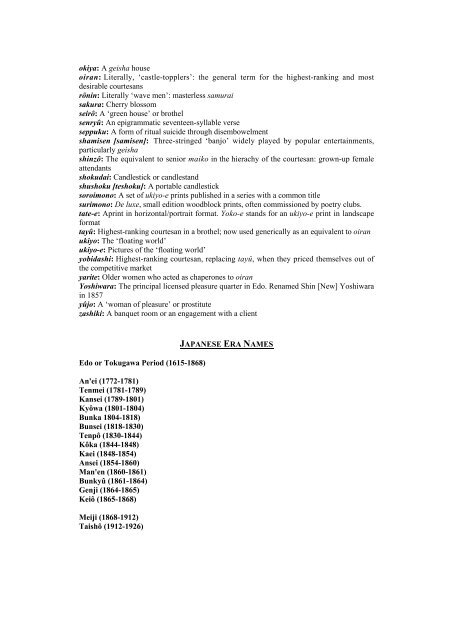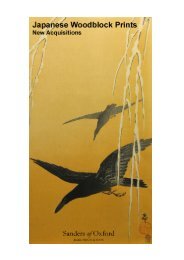You also want an ePaper? Increase the reach of your titles
YUMPU automatically turns print PDFs into web optimized ePapers that Google loves.
okiya: A geisha house<br />
oiran: Literally, ‘castle-topplers’: the general term for the highest-ranking and most<br />
desirable courtesans<br />
rônin: Literally ‘wave men’: masterless samurai<br />
sakura: Cherry blossom<br />
seirô: A ‘green house’ or brothel<br />
senryû: An epigrammatic seventeen-syllable verse<br />
seppuku: A form <strong>of</strong> ritual suicide through disembowelment<br />
shamisen [samisen]: Three-stringed ‘banjo’ widely played by popular entertainments,<br />
particularly geisha<br />
shinzô: The equivalent to senior maiko in the hierachy <strong>of</strong> the courtesan: grown-up female<br />
attendants<br />
shokudai: Candlestick or candlestand<br />
shushoku [teshoku]: A portable candlestick<br />
soroimono: A set <strong>of</strong> ukiyo-e prints published in a series with a common title<br />
surimono: De luxe, small edition woodblock prints, <strong>of</strong>ten commissioned by poetry clubs.<br />
tate-e: Aprint in horizontal/portrait format. Yoko-e stands for an ukiyo-e print in landscape<br />
format<br />
tayû: Highest-ranking courtesan in a brothel; now used generically as an equivalent to oiran<br />
ukiyo: The ‘floating world’<br />
ukiyo-e: Pictures <strong>of</strong> the ‘floating world’<br />
yobidashi: Highest-ranking courtesan, replacing tayû, when they priced themselves out <strong>of</strong><br />
the competitive market<br />
yarite: Older women who acted as chaperones to oiran<br />
Yoshiwara: The principal licensed pleasure quarter in Edo. Renamed Shin [New] Yoshiwara<br />
in 1857<br />
yûjo: A ‘woman <strong>of</strong> pleasure’ or prostitute<br />
zashiki: A banquet room or an engagement with a client<br />
Edo or Tokugawa Period (1615-1868)<br />
An'ei (1772-1781)<br />
Tenmei (1781-1789)<br />
Kansei (1789-1801)<br />
Kyôwa (1801-1804)<br />
Bunka 1804-1818)<br />
Bunsei (1818-1830)<br />
Tenpô (1830-1844)<br />
Kôka (1844-1848)<br />
Kaei (1848-1854)<br />
Ansei (1854-1860)<br />
Man'en (1860-1861)<br />
Bunkyû (1861-1864)<br />
Genji (1864-1865)<br />
Keiô (1865-1868)<br />
Meiji (1868-1912)<br />
Taishô (1912-1926)<br />
JAPANESE ERA NAMES












